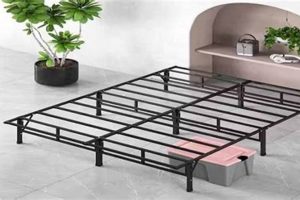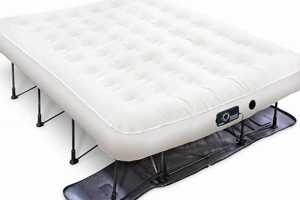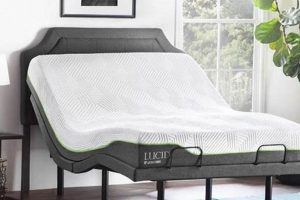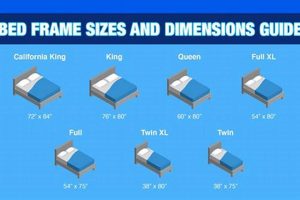A mismatch exists when attempting to place a larger mattress on a smaller bed frame. The standard dimensions of a queen mattress (60 inches wide by 80 inches long) exceed those of a full-size frame (typically 54 inches wide by 75 inches long). This dimensional difference results in an overhang and potential instability.
Employing a queen mattress with a full-size frame is inadvisable due to compromised support and safety concerns. The mattress edges extending beyond the frame lack proper support, leading to sagging, premature wear, and potential damage to the mattress. Furthermore, the instability can increase the risk of the mattress shifting or falling off the frame, posing a safety hazard.
Given the incompatibilities, a suitable bed frame should be selected that corresponds to the specific mattress size. This ensures appropriate support, extends mattress lifespan, and promotes user safety and comfort. Factors to consider when selecting a bed frame will be discussed subsequently, along with alternative solutions if a frame change is not immediately feasible.
Considerations When Mismatched Mattress and Frame Sizes Occur
Addressing the challenge of fitting a larger mattress onto a smaller frame requires careful evaluation and the implementation of practical strategies. The following points outline key considerations and actionable steps to mitigate the inherent problems associated with such a configuration.
Tip 1: Assess the Overhang: Measure the extent to which the queen mattress exceeds the full-size frame’s dimensions. A significant overhang indicates a greater risk of instability and mattress damage.
Tip 2: Evaluate Frame Support: Examine the frame’s construction and weight-bearing capacity. A flimsy frame is ill-equipped to handle the additional stress from an unsupported mattress overhang.
Tip 3: Implement Supplemental Support: If a temporary solution is necessary, consider adding supplemental support structures beneath the overhanging areas of the mattress. This may involve using sturdy platforms or boards to distribute the weight more evenly. Proceed with caution and awareness that this may be a non-permanent solution.
Tip 4: Prioritize Safety: Due to the potential instability, exercise caution when using the bed. Avoid placing excessive weight on the edges of the mattress and be mindful of potential shifting.
Tip 5: Consider a Frame Upgrade: The most reliable long-term solution is to acquire a bed frame that is specifically designed to accommodate a queen-size mattress. This ensures proper support, stability, and safety.
Tip 6: Mattress Protector Usage: A quality mattress protector is a good idea to prevent damage from the elements or from moving or sag.
Tip 7: Consider Box Spring Usage: A box spring or other solid foundation can make up the size difference and provide even support for the queen size mattress.
Implementing these strategies can help mitigate the risks associated with a mismatched mattress and frame. However, it is important to recognize that these are often temporary measures, and procuring a correctly sized frame remains the optimal course of action.
Following sections will delve into the long-term impacts and ramifications of using incorrect frame sizes.
1. Size Incompatibility
Size incompatibility is the central issue when considering the practicality of placing a queen mattress on a full-size frame. This dimensional discrepancy dictates the suitability, safety, and longevity of both components. The following outlines specific facets of this incompatibility.
- Dimensional Discrepancy and Overhang
A queen mattress measures 60 inches wide and 80 inches long, while a full-size frame is typically 54 inches wide and 75 inches long. The resulting overhang, 6 inches on each side width-wise and 2.5 inches length-wise, leads to uneven weight distribution. This unsupported overhang creates stress points on the mattress, accelerating wear and potential damage.
- Compromised Support Structure
Bed frames are designed to provide uniform support. When a mattress exceeds the frame’s dimensions, portions of the mattress lack adequate structural support. This compromise leads to sagging, particularly along the edges, impacting sleep quality and potentially causing discomfort or exacerbating back issues.
- Increased Instability and Safety Risks
The imbalance introduced by size incompatibility diminishes the stability of the overall sleep system. Movement on the mattress can cause it to shift or, in extreme cases, fall off the frame. This presents a safety hazard, especially for individuals with mobility issues or children.
- Accelerated Wear and Tear on the Frame
In addition to impacting the mattress, size incompatibility can also put undue stress on the bed frame itself. The frame may be forced to bear weight beyond its intended capacity, potentially leading to structural damage such as bent support slats or a weakened frame overall. This effect can reduce the lifespan of the bed frame.
These facets of size incompatibility highlight the inherent problems associated with attempting to pair a queen mattress with a full-size frame. While temporary solutions may exist, the long-term ramifications for both the mattress and frame necessitate using appropriately matched components for optimal support, longevity, and user safety.
2. Support compromise
The feasibility of placing a queen mattress on a full frame directly relates to the concept of support compromise. This arises because a queen mattress, designed to distribute weight across a larger surface area (60×80 inches), exceeds the dimensions of a standard full-size frame (54×75 inches). Consequently, a portion of the mattress will inevitably lack direct support from the frame, leading to uneven weight distribution. This unsupported overhang creates stress points, particularly along the edges of the mattress, potentially causing sagging, indentations, and premature wear. A practical example is observing the visible droop of mattress edges when placed on an undersized frame, a clear indication of compromised support.
The degree of support compromise also influences the overall stability and longevity of the sleeping system. The frame may not be designed to handle the redistributed weight, potentially leading to structural strain or damage. Furthermore, the lack of uniform support can negatively impact sleep quality, as the mattress surface becomes uneven. For instance, individuals sleeping near the edges of the mattress may experience discomfort due to the lack of underlying support. Therefore, support compromise is a key factor when determining the suitability of placing a larger mattress on a smaller frame; it affects mattress integrity, frame stability, and user comfort.
In summary, the connection between a full frame’s limitations and its resulting support compromise for a queen mattress underscores the need for properly matched components. Addressing concerns relating to mattress integrity, frame instability, and compromised sleep quality requires due diligence when selecting appropriately sized frames, and using the right bedframe, box spring, or other solid foundation. This adherence to compatibility enhances mattress lifespan, preserves frame integrity, and optimizes user well-being by promoting stable, well-supported sleep.
3. Safety hazard
The incongruity between a queen mattress and a full-size frame introduces several potential safety hazards. Placing a queen mattress, designed for a larger support structure, on a smaller full frame results in portions of the mattress extending beyond the frame’s perimeter. This overhang creates an unstable sleeping surface, particularly along the edges. A direct consequence is an increased risk of falls, especially for individuals with limited mobility or during nighttime movement. The unsupported mattress edges can unexpectedly give way, leading to injury. Furthermore, this instability can become a significant concern for children, who may be more prone to accidents while playing or moving on the bed.
Beyond the immediate risk of falls, the structural compromise caused by the mismatched sizes can lead to longer-term safety issues. The bed frame, subjected to uneven weight distribution, may experience undue stress and eventual failure. Broken frame components can pose a hazard, with sharp edges or unstable structures increasing the likelihood of injury. For instance, a collapsing support slat could cause the mattress to shift suddenly, potentially trapping or injuring someone. Real-world scenarios involving individuals falling from beds or sustaining injuries from broken bed frames underscore the practical significance of understanding and mitigating the safety risks associated with mismatched mattress and frame sizes.
In summary, the safety hazard resulting from placing a queen mattress on a full frame is a multifaceted issue encompassing immediate fall risks and longer-term structural instability. Addressing this concern requires prioritizing the use of appropriately sized bed frames to ensure a stable and safe sleep environment. Mitigation strategies focus on selecting frames designed to adequately support the mattress, thereby minimizing the potential for accidents and injuries. Proper bed frame selection is not merely a matter of aesthetics or comfort; it is a critical component of ensuring user safety.
4. Mattress damage
Placing a queen mattress on a full-size frame initiates a cascade of events leading to premature and potentially irreversible mattress damage. The dimensional mismatch concentrates stress along the unsupported edges of the mattress. This localized stress accelerates the breakdown of internal mattress components, including coils, foam layers, and fabric coverings. Over time, this results in visible sagging, indentations, and a reduction in overall support. A common manifestation of this damage is the formation of a permanent “sinkhole” along the mattress edges, compromising sleep quality and diminishing the mattress’s structural integrity. This degradation is not merely cosmetic; it affects the mattress’s ability to provide proper spinal alignment and support, potentially leading to discomfort and health-related issues.
The rate and severity of mattress damage are influenced by several factors, including the mattress type, the weight of the individuals using it, and the duration of the mismatch. Hybrid mattresses, with their complex layering of materials, are particularly vulnerable to damage when improperly supported. Individuals with higher body weights exacerbate the stress on unsupported edges, accelerating the degradation process. Moreover, the longer a queen mattress remains on a full-size frame, the more pronounced and irreversible the damage becomes. For example, a memory foam mattress, known for its conforming properties, will permanently mold to the contours of the unsupported surface, losing its original shape and support capabilities. This highlights the importance of addressing the size discrepancy promptly to mitigate potential long-term damage.
Ultimately, using a queen mattress on a full-size frame creates a scenario where mattress damage is virtually inevitable. The uneven weight distribution and lack of edge support undermine the mattress’s structural integrity, leading to premature wear, sagging, and a reduction in overall performance. Addressing the dimensional mismatch through the use of an appropriately sized bed frame is crucial for preserving the mattress’s lifespan and ensuring optimal sleep quality. Ignoring this issue not only compromises comfort and support but also represents a significant financial loss due to the accelerated need for mattress replacement.
5. Frame stress
The act of placing a queen-size mattress upon a full-size bed frame introduces undue stress on the supporting structure. This stress arises from the dimensional incompatibility between the two components. A queen mattress, designed to distribute its weight across a larger surface area (60 inches by 80 inches), extends beyond the confines of a full-size frame (typically 54 inches by 75 inches). This overhang concentrates a significant portion of the mattress’s weight, along with the weight of its occupants, onto the edges of the frame. The frame, not engineered to bear this additional load in these specific areas, experiences heightened stress levels. An immediate consequence is potential bending or warping of the frame’s support slats or side rails. Over time, this can lead to structural weakening and eventual failure of the frame.
The type of frame material significantly influences the degree of stress experienced. Frames constructed from solid hardwoods are generally more resistant to bending and warping than those made from softer woods or composite materials. Metal frames, while often stronger than wood, are susceptible to bending or weld failure under prolonged stress. Consider a scenario where a couple uses a queen mattress on a full-size metal frame. The concentrated weight, particularly if one or both individuals are above average weight, could cause the metal slats to gradually bend inward, compromising the mattress’s support and potentially leading to a complete collapse of the frame. The practical implication is that the lifespan of the full-size frame is significantly reduced when forced to support a queen mattress.
In conclusion, frame stress is a direct and unavoidable consequence of using an improperly sized mattress. The concentrated weight and uneven distribution lead to accelerated wear and potential structural failure of the bed frame. Mitigating this risk requires selecting a frame that is specifically designed to accommodate the dimensions and weight of the mattress. Failing to do so not only compromises the stability and longevity of the bed frame but also poses a potential safety hazard to the occupants. Choosing the appropriate frame is, therefore, a crucial consideration for ensuring both comfort and structural integrity.
6. Longevity reduced
The concept of reduced longevity is a critical consequence when addressing the question of placing a queen mattress on a full-size frame. This section explores how dimensional mismatch directly impacts the lifespan of both the mattress and the frame, leading to premature wear and eventual replacement.
- Uneven Weight Distribution and Material Fatigue
When a queen mattress overhangs a full-size frame, weight is not evenly distributed. This concentrated stress on specific areas of the mattress accelerates material fatigue. Coils become compressed, foam layers break down prematurely, and fabric coverings experience increased wear. For example, the edges of the mattress may sag significantly faster than the center, leading to an uneven sleeping surface and reduced support. This degradation shortens the overall lifespan of the mattress.
- Compromised Frame Integrity and Structural Weakening
The undersized frame is subjected to stresses beyond its design capacity. The added weight and uneven distribution can cause warping, bending, or even breakage of frame components. Wooden frames may develop cracks, while metal frames can experience weld failures. An example is observing bent support slats or a bowed side rail on a full-size frame attempting to support a queen mattress. These structural weaknesses reduce the frame’s ability to provide adequate support, further accelerating mattress wear and shortening its own lifespan.
- Increased Susceptibility to Damage from External Factors
A mismatched mattress and frame are more susceptible to damage from external factors such as humidity, temperature fluctuations, and physical impacts. The compromised structure offers less protection against these elements, leading to accelerated degradation. For instance, a mattress with sagging edges is more likely to absorb moisture, promoting mold growth and further reducing its lifespan. Similarly, a weakened frame is more vulnerable to breakage from accidental bumps or movements.
- Loss of Warranty Coverage Due to Improper Use
Many mattress and frame warranties are voided if the products are used in a manner inconsistent with the manufacturer’s instructions. Placing a queen mattress on a full-size frame typically constitutes misuse, as it deviates from the intended support configuration. Consequently, any damage or defects arising from this improper use may not be covered by the warranty, leaving the owner responsible for the full cost of repairs or replacement. This financial implication further underscores the reduced longevity associated with the mismatch.
In summary, the reduced longevity of both the mattress and frame is a significant consequence of placing a queen mattress on a full-size frame. The uneven weight distribution, compromised structural integrity, increased susceptibility to damage, and potential loss of warranty coverage all contribute to a shorter lifespan for both components. This underscores the importance of using appropriately sized bed frames to ensure optimal support, longevity, and overall value.
7. Aesthetic discord
A noticeable visual imbalance emerges when a queen-size mattress is placed on a full-size bed frame. This aesthetic discord stems from the mattress’s overhang, disrupting the intended proportions of the bed. The excess material extending beyond the frame creates an unkempt appearance, detracting from the room’s overall design. The intended harmony between furniture pieces is compromised, resulting in a visually jarring effect. A direct example of this is evident in bedrooms where a carefully curated aesthetic is undermined by the ill-fitting mattress, regardless of the quality of the bedding or other decorative elements.
The impact of this visual imbalance extends beyond mere aesthetics; it can influence the perceived quality and value of the entire bedroom ensemble. A neatly made bed typically projects an image of order and comfort. However, the awkward fit of the mattress detracts from this perception, suggesting a lack of attention to detail or a compromise in functionality. This discord is further amplified if the bed frame itself is a visually prominent piece. The contrast between the intentional design of the frame and the unintended overhang of the mattress creates a visual conflict. A hotel room attempting to project luxury would immediately fall short of its goal with a mismatched mattress and frame, regardless of other high-end amenities.
In summary, the aesthetic discord resulting from placing a queen mattress on a full-size frame represents a significant detraction from the overall visual appeal of a bedroom. The resulting imbalance undermines the harmony and intended design, impacting the perceived quality and value of the space. Recognizing and addressing this issue by selecting appropriately sized components ensures a cohesive and visually pleasing aesthetic, ultimately contributing to a more comfortable and well-designed living environment. The practical significance of this understanding lies in the importance of considering the overall aesthetic impact when making furniture choices, as even functional compromises can have unintended visual consequences.
Frequently Asked Questions
The following addresses common inquiries concerning the compatibility of queen-size mattresses with full-size bed frames. These responses aim to provide clarity and inform decision-making based on sound principles.
Question 1: Is it physically possible to place a queen mattress on a full frame?
While the physical act of placing the larger mattress upon the smaller frame is achievable, it is not recommended. The overhang created leads to compromised support and potential damage to both the mattress and frame.
Question 2: What are the primary risks associated with using a queen mattress on a full frame?
The main risks include uneven weight distribution, accelerated wear and tear on the mattress, structural stress on the frame, potential instability leading to falls, and voiding of warranty coverage for both the mattress and the frame.
Question 3: Can additional support structures mitigate the risks of a size mismatch?
Supplemental support, such as boards or platforms, can offer temporary relief. However, these measures do not fully address the underlying issue of uneven weight distribution and are not a substitute for a correctly sized frame.
Question 4: Will a box spring or foundation alleviate the problems associated with the size difference?
A box spring or foundation matching the queen mattress’s dimensions will extend beyond the full frame. While providing more even support than the bare frame, it does not resolve the frame’s inability to properly support the perimeter of the mattress, and the issue with the frame remains unaddressed.
Question 5: How does this size difference affect sleep quality and spinal alignment?
Uneven weight distribution and sagging edges can compromise spinal alignment, potentially leading to discomfort, back pain, and disrupted sleep patterns. Proper support is crucial for maintaining a healthy sleeping posture.
Question 6: What is the recommended solution for a queen mattress owner with only a full-size frame available?
The optimal solution is to acquire a bed frame specifically designed to accommodate a queen-size mattress. This ensures proper support, stability, and longevity for both the mattress and the frame. Short of replacing the frame, consider a platform to create an even surface under the whole mattress, but this is also a short term fix to the issue.
In summary, attempting to force a queen mattress onto a full frame presents a multitude of challenges and potential problems. The most prudent approach involves using appropriately sized components to ensure optimal comfort, support, and safety.
Next will be a conclusion to summarize all of this.
Can You Put Queen Mattress on Full Frame
This exploration has demonstrated the considerable challenges associated with placing a larger mattress on a smaller frame. From compromised support and accelerated wear to potential safety hazards and aesthetic discord, the incompatibilities are multifaceted and significant. The analysis underscores the necessity of proper size matching to ensure structural integrity, longevity, and user well-being.
Therefore, while the physical act of forcing a queen mattress onto a full frame may be possible, it is strongly discouraged. A properly sized frame remains the optimal solution, warranting careful consideration to promote safety, comfort, and the preservation of valuable furnishings.


![Best Queen Futon Frame and Mattress Sets: [Year] Guide Organic & Natural Mattress Buyer’s Guide: Non-Toxic Sleep Solutions Best Queen Futon Frame and Mattress Sets: [Year] Guide | Organic & Natural Mattress Buyer’s Guide: Non-Toxic Sleep Solutions](https://mattressworldpa.com/wp-content/uploads/2025/07/th-3093-300x200.jpg)



![Best Blow Up Air Mattress with Frame [Guide] Portable Beds Organic & Natural Mattress Buyer’s Guide: Non-Toxic Sleep Solutions Best Blow Up Air Mattress with Frame [Guide] Portable Beds | Organic & Natural Mattress Buyer’s Guide: Non-Toxic Sleep Solutions](https://mattressworldpa.com/wp-content/uploads/2025/07/th-3089-300x200.jpg)
